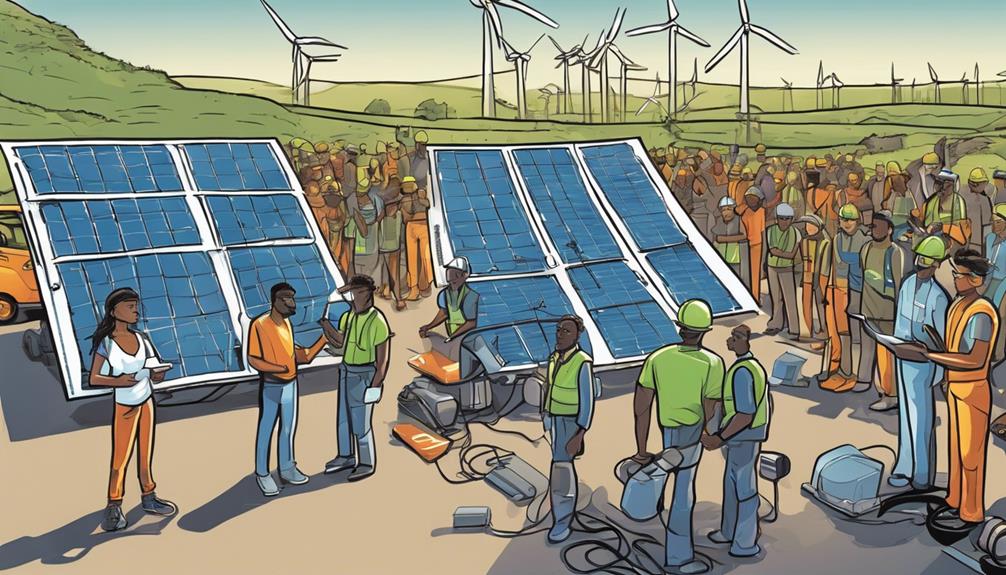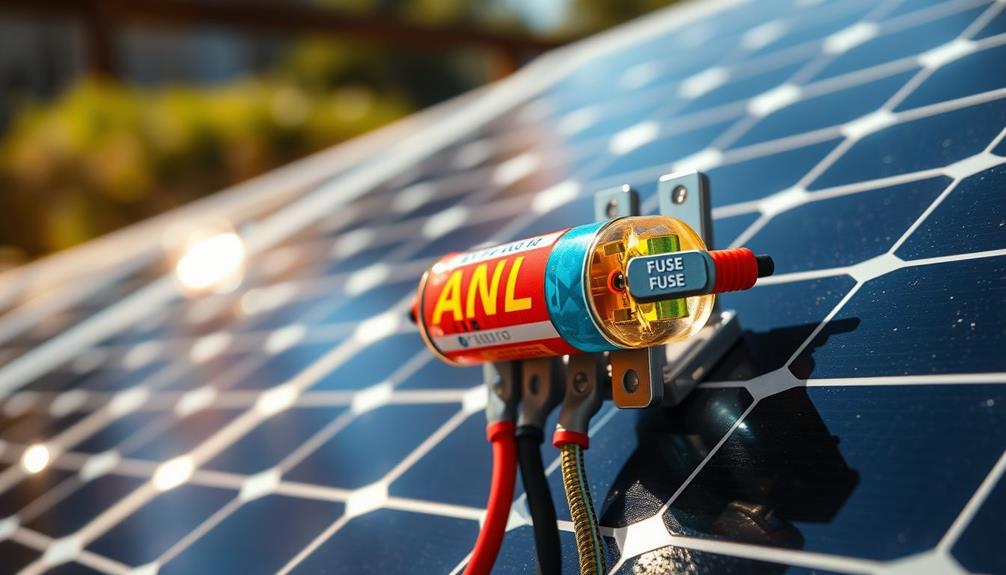Get ready to empower your workforce for a renewable future with targeted training and skill development initiatives. Tailor programs to meet the changing energy landscape, focusing on hands-on learning and theoretical knowledge. Assess current staff competencies, aligning them with industry needs through personalized plans. Invest in green energy expertise and efficient recruitment strategies. The renewable energy sector is booming, offering vast job opportunities – are you prepared?
Key Takeaways
- Invest in specialized training for solar, wind, and hydro power.
- Blend hands-on experience with theoretical knowledge for effective learning.
- Prepare workforce for clean energy technology demands through skill development.
- Collaborate among industry, education, and government for workforce alignment.
- Ensure career mobility by adapting existing skills to new renewable energy roles.
The Changing Energy Landscape
Amidst global shifts towards cleaner energy sources, the energy landscape is undergoing a significant transformation. The clean energy industry is flourishing, with renewable energy technologies like solar and wind power experiencing remarkable growth. This expansion not only reflects a shift towards more sustainable practices but also presents vast job opportunities in renewable energy jobs.
As the energy evolution progresses, the demand for skilled workers in this sector continues to rise, creating diverse career pathways for individuals interested in contributing to a greener future.
With renewable power capacity on the rise, workforce development becomes pivotal to meet the needs of the evolving clean energy industry. Training programs focusing on renewable energy technologies are essential to equip individuals with the skills required to thrive in this changing landscape. The increasing adoption of solar and wind power, along with the established role of hydroelectric power, underscores the importance of preparing a skilled workforce capable of driving the renewable energy sector forward.
Navigating Workplace Skill Development
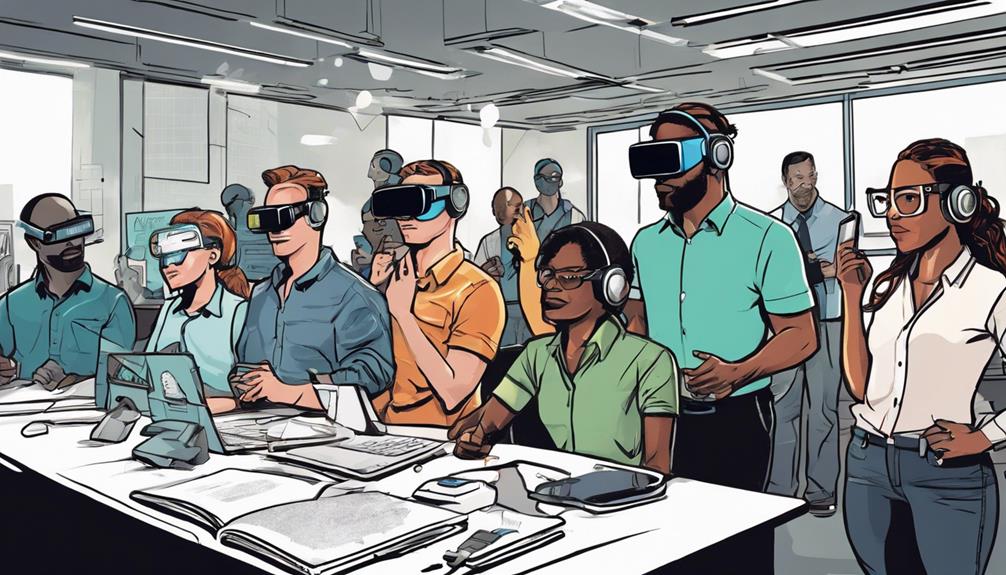
You need to understand the strategies for acquiring new skills, evaluate training programs effectively, and assess your workplace competencies to navigate skill development successfully in the renewable energy sector.
These points will help you tailor your training to meet the demands of the evolving industry and guarantee you stay competitive in the renewable energy job market.
Skill Acquisition Strategies
Understanding workplace skill development in the renewable energy sector requires a strategic approach tailored to the evolving demands of clean energy technologies. To navigate this landscape effectively, consider the following strategies:
- Invest in Specialized Training Programs: Companies are developing training programs focused on renewable energy technologies to equip the workforce with the necessary skills.
- Blend Hands-On Experience with Theoretical Knowledge: Combining practical experience with theoretical learning is essential to prepare workers for clean energy jobs.
- Leverage Existing Skills: Workers can shift their expertise from the fossil fuel industry to new roles in renewable energy by upskilling or reskilling.
- Emphasize Continuous Development: Continuous learning and adaptation are vital to staying relevant in the ever-changing renewable energy sector.
- Align Workforce with Future Demands: Focusing on aligning the workforce with upcoming energy sector needs ensures a skilled and prepared workforce for the shift to renewable energy.
Training Program Evaluation
When evaluating training programs for workplace skill development, measuring the effectiveness of skills initiatives is important for evaluating their impact.
Examining skill improvement through employee performance metrics before and after training is vital in determining the success of training programs.
Analyzing training outcomes, such as improved productivity and job performance, provides insights into the effectiveness of the programs in developing the workforce's skills.
Additionally, gathering employee feedback on the relevance and impact of training on their job roles helps in understanding the practical implications of the training initiatives.
Utilizing metrics like retention rates and promotion rates further aids in evaluating the long-term impact of training programs on energy workforce skill development.
Workplace Competency Assessment
To guarantee workforce readiness in the renewable energy sector, conducting workplace competency assessments is critical for aligning employee skills with organizational objectives and fostering continuous learning.
Workplace competency assessment involves evaluating employees' skills, knowledge, and abilities to identify strengths and areas for development.
Here are some key points to take into account:
- It helps in aligning workforce skills with organizational goals and identifying training needs for career advancement.
- Competency assessments can be conducted through observation, interviews, performance reviews, and self-assessment tools.
- These assessments aid in creating personalized development plans, enhancing job performance, and fostering a culture of continuous learning.
- By conducting regular competency assessments, organizations can ensure that their workforce is well-equipped to thrive in the evolving renewable energy sector.
Ensuring that employees receive the necessary training and development opportunities through competency assessments is essential for both individual growth and organizational success in the dynamic renewable energy sector.
Staffing and Recruitment Implications

Agencies in the renewable energy sector must prioritize training programs for current employees and actively seek candidates with green energy expertise to address staffing requirements effectively.
Strategic staffing solutions, such as temporary or project-specific staffing, are essential for accommodating the specialized skills needed in dynamic green energy projects.
Collaborating with educational institutions is key to shaping curriculum and ensuring graduates are prepared for green energy roles, establishing a skilled workforce pipeline.
Embracing ethical recruitment practices and promoting diversity in hiring are vital for fostering inclusivity and driving innovation within the sector.
Employing data analytics can provide valuable insights into understanding skill gaps and predicting future staffing needs, enabling companies to strategically recruit in the ever-evolving renewable energy industry.
Understanding Renewable Energy Transition

With the increasing global capacity of renewable power and the growing importance of renewable energy sources in the electricity generation sector, understanding the dynamics of this shift is vital.
To grasp the nuances of the renewable energy transformation, consider the following:
- Global Growth: Renewable power capacity surged by 9.6% in 2022.
- Electricity Generation: Renewable energy contributed 29% to electricity generation in 2020.
- Solar Expansion: Solar energy witnessed a remarkable 22% growth in 2022.
- Wind Power Increase: Wind power capacity escalated by 17% in 2022.
- Hydropower Role: Hydroelectric power played a significant role, contributing 16.8% to electricity generation in 2020.
Understanding these trends is essential for workforce training and skill development in clean energy technologies.
As the renewable energy sector expands, training initiatives must align with the evolving energy systems to meet the demand for jobs in this sector.
Stay informed to make informed decisions in this dynamic field.
Workforce Development Blueprint
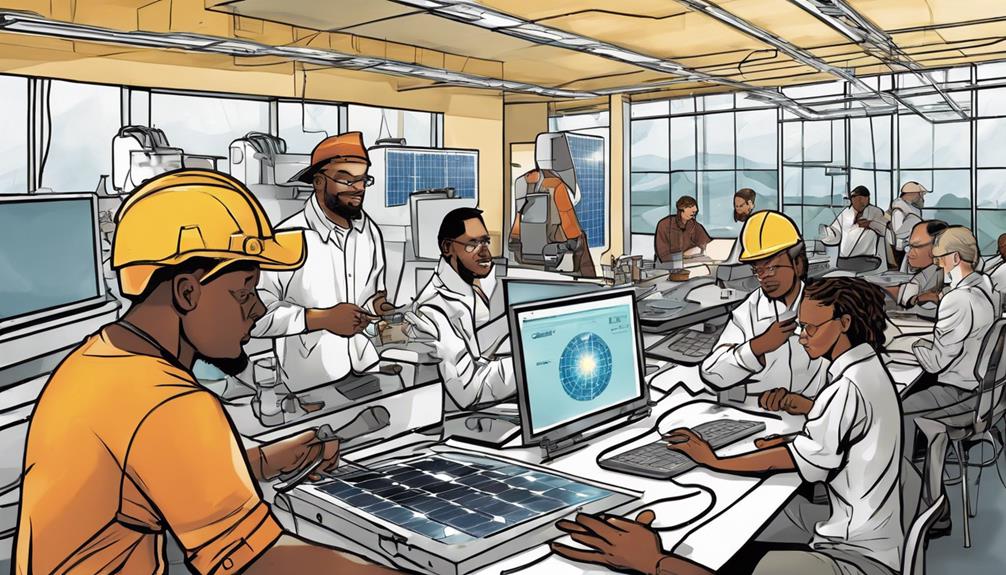
You'll explore the essential components of skill training programs, industry alignment strategies, and career mobility initiatives in the renewable energy sector.
These points are vital for preparing the workforce for the demands of clean energy technologies like solar, wind, and hydro power.
Skill Training Programs
In designing effective skill training programs for the renewable energy sector, a thorough workforce development blueprint is necessary.
When it comes to skill training programs in clean energy, it's important to focus on specialized skills tailored to technologies like solar, wind, and hydro power.
To make sure workers are well-prepared, these programs integrate hands-on experience with theoretical knowledge.
Additionally, existing skills can be repurposed and applied in new areas within the renewable energy field, offering opportunities for career growth.
Continuous skill development is emphasized to keep up with the evolving demands of the industry.
Industry Alignment Strategies
To guarantee a skilled workforce ready to meet the demands of the renewable energy sector, industry alignment strategies focus on matching job requirements with workforce training and capabilities. These strategies involve identifying skill gaps, developing training programs, and aligning workforce capabilities with the evolving needs of the renewable energy sector.
Collaboration among industry stakeholders, educational institutions, and government agencies is essential for designing effective workforce development blueprints that address the growing demand for skilled workers in renewable energy technologies. By ensuring that the workforce is equipped with the necessary skills and knowledge, these strategies play a pivotal role in supporting the advancement to a renewable energy future.
Industry-aligned workforce development blueprints aim to bridge the gap between the skills possessed by the workforce and those required by the renewable energy industry, ultimately fostering a workforce that's well-prepared to contribute to the sector's growth and sustainability.
Career Mobility Initiatives
Amid the dynamic landscape of the renewable energy sector, career progression initiatives within the workforce development blueprint are crucial for addressing skill gaps and preparing workers for emerging roles.
Career progression initiatives in renewable energy focus on providing specialized training programs tailored to the evolving demands of the sector. By encouraging workers to adapt their existing skills to new roles, these programs guarantee a skilled and adaptable workforce for the renewable energy shift.
The emphasis is on continuous skill development to keep pace with the changing requirements of the industry.
Key features of career progression initiatives include:
- Tailored specialized training programs
- Adapting existing skills to new roles
- Continuous skill development emphasis
- Alignment with evolving sector demands
- Guaranteeing a skilled and adaptable workforce
Future-Proof Skills for Renewable Energy
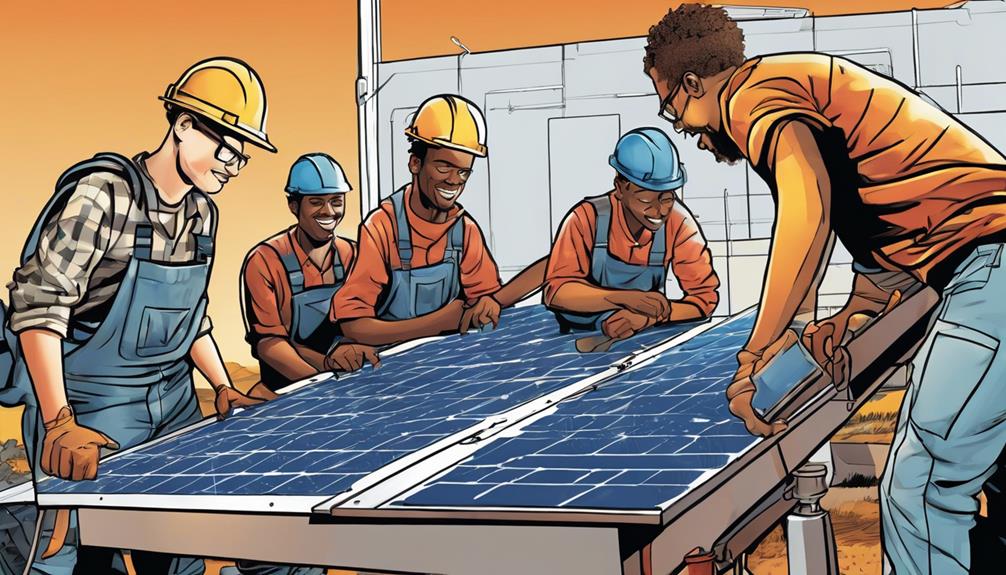
With the rapid growth and demand in the renewable energy sector, developing future-proof skills has become imperative for professionals looking to thrive in this evolving industry.
The projected creation of 14 million new jobs by 2030 underscores the importance of acquiring skills that align with the industry's needs.
As global renewable power capacity is set to increase by 2,400 GW by 2027, the demand for a skilled workforce is evident.
Particularly in wind energy, where the workforce is expected to grow by over 50% by 2030, the necessity for relevant skills development is paramount.
Frequently Asked Questions
What Are the Projections for Renewable Energy Sector Employment?
In the renewable energy sector, job growth is soaring. By 2030, 14 million new jobs are expected, while the fossil fuel industry might lose 5 million. Wind energy alone could create 936,000 jobs in the EU.
How Many People Work in Renewable Energy in the Us?
Over 415,000 people were employed in the US solar industry in 2020. That number reflects a growing workforce dedicated to renewable energy. Are you ready to immerse yourself in a field that's not only promising but also sustainable?
What Is the Fastest Growing Sector of Renewable Energy?
Wind power stands out as the fastest growing sector of renewable energy. Demand for wind turbine service technicians is expected to surge by nearly 45% from 2022 to 2032, showcasing the industry's rapid expansion.
Is Energy Renewable?
Oh, absolutely! Energy is renewable, like a never-ending buffet of nature's goodies. Sun, wind, water – all there for the taking. It's a sustainable party that just keeps on going!
How Can Workforce Training Prepare Individuals for the Shift to Solar Power and Sustainable Logistics?
Workforce training is crucial for the sustainable logistics future solar power. By equipping individuals with the necessary skills and knowledge, they can seamlessly transition to careers in the solar power industry and contribute to sustainable logistics practices. Proper training ensures a smooth shift towards a more environmentally friendly and efficient future.
Conclusion
As you prepare for the renewable energy future, keep in mind that the demand for solar photovoltaic installers is projected to grow by 51% from 2020 to 2030.
By investing in training and skill development now, you can position yourself for success in this rapidly expanding industry.
Stay ahead of the curve and guarantee you have the necessary skills to thrive in the renewable energy workforce of tomorrow.
